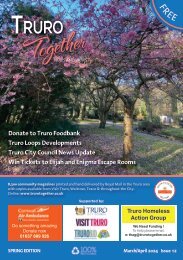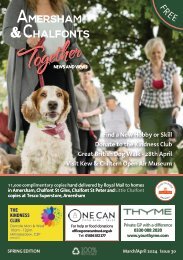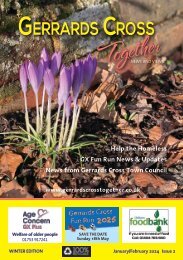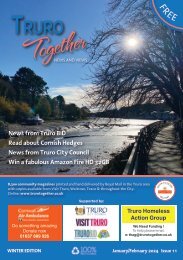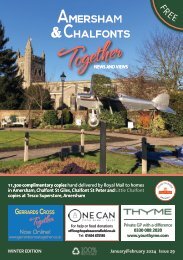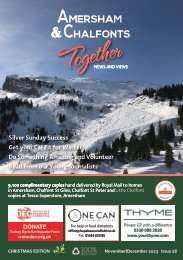Beaconsfield Together September October 2022
A local #community magazine containing community, business and charitable editorial in the Beaconsfield, Knotty Green, Seer Green and Forty Green area. 8,300 copies printed and hand delivered by Royal Mail to residences and businesses in the HP9 -1 and HP9 -2 businesses in these areas. Copies available at Waitrose Supermarket in Beaconsfield
A local #community magazine containing community, business and charitable editorial in the Beaconsfield, Knotty Green, Seer Green and Forty Green area. 8,300 copies printed and hand delivered by Royal Mail to residences and businesses in the HP9 -1 and HP9 -2 businesses in these areas. Copies available at Waitrose Supermarket in Beaconsfield
You also want an ePaper? Increase the reach of your titles
YUMPU automatically turns print PDFs into web optimized ePapers that Google loves.
WHY THERMOGRAPHY IS THE ‘W<br />
FOR REDUCING HE<br />
and improving the quality and efficiency of insulation methods as<br />
part of the conservation of traditional, older and ancient buildings<br />
by Robert Tiffin, Eco Tiffin Ltd<br />
It might not seem entirely intuitive to consider the<br />
use of modern technology when working with<br />
traditional and ancient buildings. However, building<br />
conservation should make use of all the knowledge,<br />
skills and disciplines at its disposal and it would be<br />
a big mistake to dismiss thermography, especially<br />
now, with energy costs predicted to be capped at<br />
£2,800 a year for the average home by <strong>October</strong><br />
<strong>2022</strong>.<br />
Thermography is the use of thermal infrared<br />
imaging to identify heat loss contributing building<br />
defects such as dampness and its sources. It is<br />
a non-destructive technique that is ideal when<br />
working with older, complex buildings that have so<br />
many elements to them. Indeed, it is impossible to<br />
make a full and accurate assessment of their state<br />
of repair without recourse thermography in the<br />
hands of a seasoned building professional.<br />
A condition survey incorporating an analysis of<br />
all heat loss areas, building defects and drafts in<br />
relation to the current or proposed use of any building<br />
is a prerequisite for the correct identification and<br />
specification of any insulation (retrofit) works needed,<br />
well before their approval and commencement.<br />
Identifying the exact type of structure and its fabric<br />
enables us to determine its thermal envelope, how<br />
good or bad it is at retaining the warm air that is so<br />
expensive to heat, and therefore form a strategy on<br />
how best to reduce it.<br />
More than any other technology, the thermal<br />
images shown here shows the interplay of moisture,<br />
heat and ventilation continuously unfolding in any<br />
building. It allows us to better understand/see what<br />
is going on, explain it and make better informed<br />
decisions when prioritising the allocation of everlimited<br />
resources. Which means we should be<br />
thinking of thermography as a sixth sense that we<br />
are very lucky to have.<br />
Because of the highly visual, immediate<br />
nature of the thermal survey, it offers a relatively<br />
inexpensive and non-invasive way of helping<br />
clients and other stakeholders understand the<br />
significance of heat loss and potential problems<br />
Uninsulated light tube<br />
Poorly installed cavity wall<br />
insulation<br />
Poorly fitted horizontal loft<br />
insulation<br />
Get in touch today to<br />
book a consultation<br />
and find out more<br />
30 <strong>Beaconsfield</strong> <strong>Together</strong> is part of Community <strong>Together</strong>





